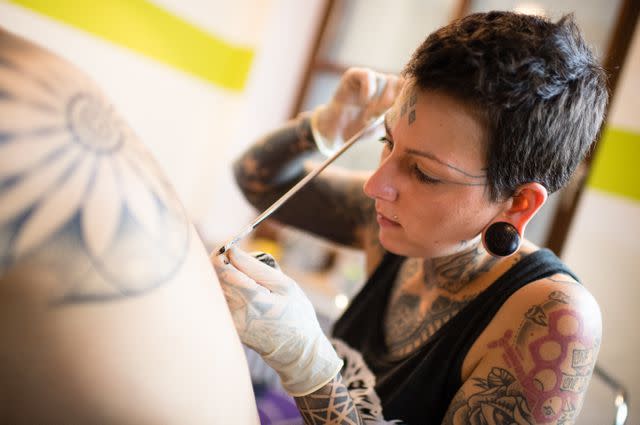A Definitive Guide to Stick-and-Poke Tattoos

Getty Images
Stick-and-poke tattoos are essentially the OGs of body modification. A European Tyrolean Iceman buried around 3250 B.C. (5,300 years old!) was discovered to have 61 tattoos all over his body. Essentially, humans have been marking their bodies to signify status, accomplishments, societal roles, and ornamentation for thousands of years.
The advent of tattoo machines made the process faster and allowed for more elaborate designs. Later years saw stick-and-poke tattoos re-emerge in popularity as part of the underground punk subculture as a sign of rebellion.
Related: Everyone's Getting Dainty Tattoos Right Now
More recently, the artsy, hand-drawn appeal of stick-and-poke tattoos has become popular on social media. After all, quarantine meant visits to tattoo artists became less viable, and expensive tattooing equipment was difficult to track down. Although DIYing your own tattoo (or someone else’s) when you are not a professional is not advisable, the appeal of stick-and-poke tattoos, with their dainty fine lines and dot work, has left an impression on tattoo trends.
We teamed up with Jingxi Gu, who specializes in Chinese painting and traditional Asian styles, both of which are rooted in ancient Chinese Art and translated into today’s most visible and intimate canvas: the human body. She is the owner and lead artist at Patch Tattoo Therapy in Tarzana, CA, which offers custom tattoos and tattoo training workshops for aspiring tattoo artists.
Jingxi Gu, owner and lead artist at Patch Tattoo Therapy in Tarzana, CA.
Fernando Morales Unda is a tattoo artist in West Hollywood.
Stick and Poke Tattoos, Explained

Getty Images
Stick-and-poke tattoos are an ancient form of tattoo done by hand without a tattoo machine that has been practiced by Indigenous, Polynesian, and ancient Mediterranean cultures for thousands of years. Gu has observed this traditional tattoo practice gain popularity over the last ten years as tattoo artists return to tradition to create both referential and more modern tattoos.
The tattoo process most commonly used in Western culture over the last several decades is carried out using a tattoo machine consisting of a small needle or group of needles that inserts ink under the skin through needles 80 to 150 times per second. Stick-and-poke tattoos take the entire process back to its basics before the invention of elaborate machinery or electricity.
As the name describes, the artist will stick and poke your skin with tiny dots where the ink goes in, versus a machine which basically does the same thing but at a higher speed with a rotor- or a coil-based machine, according to tattoo artist Fernando Morales Unda, a self-taught artist originally from Mexico who is known for his extreme realism.
“During the process of stick-and-poke, the artist dips a single needle in ink and deposits the ink in a back-and-forth motion, but instead of using an electric-powered machine, the momentum and power are all from the fingers, wrists, and arms,” explains Gu.
Stick-and-Poke Tattoo vs. Machine Tattoo
If you are trying to choose between a stick-and-poke tattoo or one performed using a machine, you’ll first want to figure out what you want your tattoo to look like.
“Stick-and-poke tattoos are cute, and there are certainly really talented artists out there that do them, but if we're talking about actual results, an artist with a great command of a tattoo machine is able to create better tattoos,” admits Gu.
Tattoos done with a tattoo machine are faster and more efficient, precise, and consistent; they create less trauma to the skin, there are more needle configurations, there is reduced risk of overworking the skin, and more complex designs.
Proper tattooing involves using just the right technique to avoid messy-looking or quick-fading tattoos. Morales Unda explains that we all have three layers of skin: epidermis (superficial), dermis ( second layer), and hypodermis (three-layer or subcutaneous tissue). The second layer of the skin is where tattoos should be placed. If an artist goes too deep, there are blowouts, which look like blurred lines and unclear imagery. If the tattoo is too superficial, it won’t last.
Related: What Are Fingernail Tattoos? Here's Everything to Know About 2023's Hottest Ink Trend
Correct technique is important, especially when working with smaller needles, according to Morales Unda. “It’s a common misconception that the smaller the tattoo, the easier; it is actually the opposite,” he says. Additionally, although typically more simplistic in design, stick-and-poke tattoos take longer to create due to their by-hand nature. However, they are also more affordable and can be more unique due to their hand-drawn appearance.
“I do think that stick-and-poke tattoos have their own unique charm and simplicity. They can be seen as a more intimate and hands-on approach to tattooing,” says Gu. Ultimately, the choice between tattoo machines and stick-and-poke tattoos depends on personal preference, the complexity of the design, and the level of professionalism needed. Seeking professional opinion and guidance from a reputable tattoo artist is best before making a permanent decision.
Stick-and-Poke Tattoo Process

Getty Images
Compared to getting a tattoo with a machine, the process is the same, except the artist isn't using a tattoo machine. Gu provided a breakdown of the process that typically goes like this:
Generating the concept of your tattoo and deciding what you want
Consultation between artist and client
Cleaning and sanitizing the tattoo station
Stenciling (if needed)
Tattooing procedure
Cleaning the affected area and covering it with a sterile dressing
Aftercare and healing
Optional touch-up
So what about everyone’s burning question: How painful is it, really? “Stick-and-poke tattoos are generally less painful for some people as the needle is manually applied and doesn't penetrate the skin as deeply,” says Gu. However, pain tolerance varies from person to person, and some discomfort is expected.
Safety and Aftercare
The most important aspect of tattoo safety is hygiene. This means not letting your cousin tattoo you in their kitchen. Ensure you go to a professional, reputable tattoo artist with some solid experience in stick-and-poke tattooing and, preferably, plenty of rave reviews. Take a look at the artist’s gallery as well to see if their style matches your expectations.
After your tattoo, the aftercare process is vital for healing and preventing infection. “Leave the sterile bandage on for a few hours, gently cleanse the tattoo with lukewarm water and fragrance-free soap, then pat dry the tattoo and apply a thin layer of ointment such as Aquafor,” Gu instructs.
Related: How to Care for a New Tattoo
Gu also recommends avoiding over-moisturizing, water immersion, sun exposure, picking or scratching, loose clothing, and physical activities. It’s also crucial to stay hydrated, eat well, and follow your artist's instructions, according to Gu. These steps will ensure your tattoo looks its best for years to come.
Bottom Line
Morales Unda says that if you want a hand-poke tattoo for the experience, you should go for it, and there are many incredible hand-poke artists. “Hand-poke tattoos are a trend right now,” says Morales Unda. “The idea of ‘going back to the roots’ or having a different experience is great. But if you want something that has more complexity and lasts the same way forever, I’d advise you to do your research and go with an experienced tattoo artist that does the style you’d want to get,” he adds.
Always do your research and be sure the artist you choose can create the style you want. Take a look at the healed work in their portfolio to get a sense of their typical results.
For more InStyle news, make sure to sign up for our newsletter!
Read the original article on InStyle.

